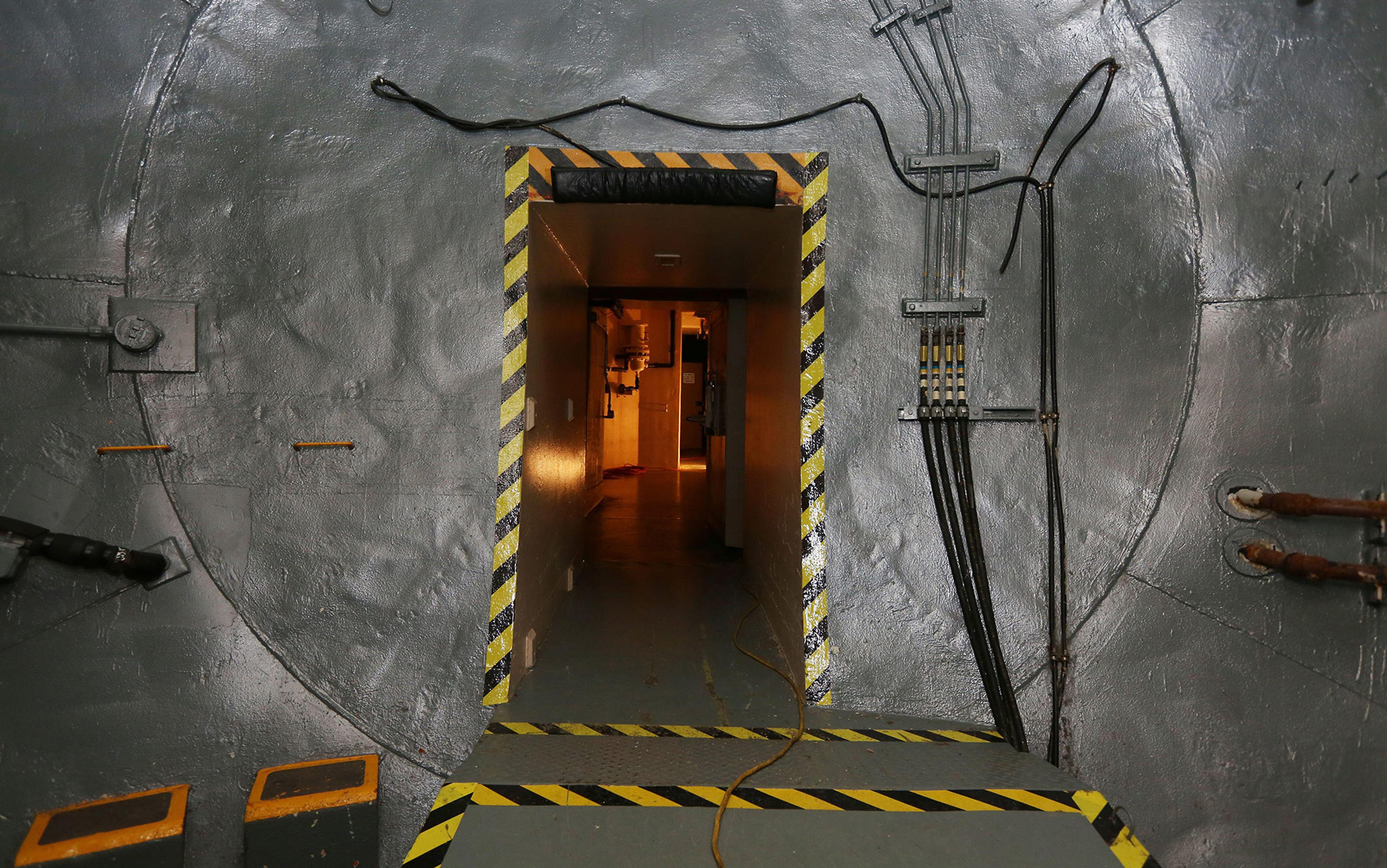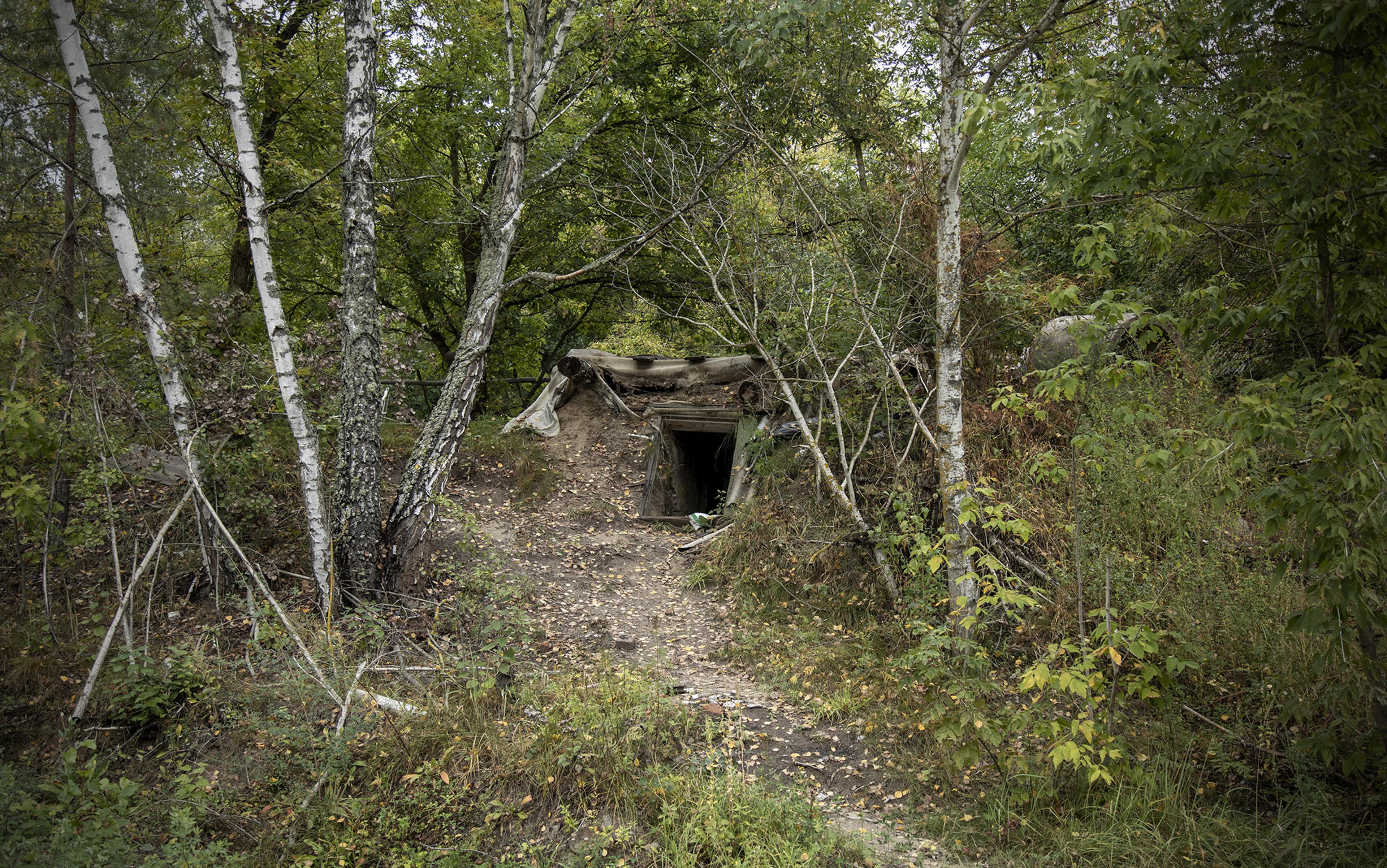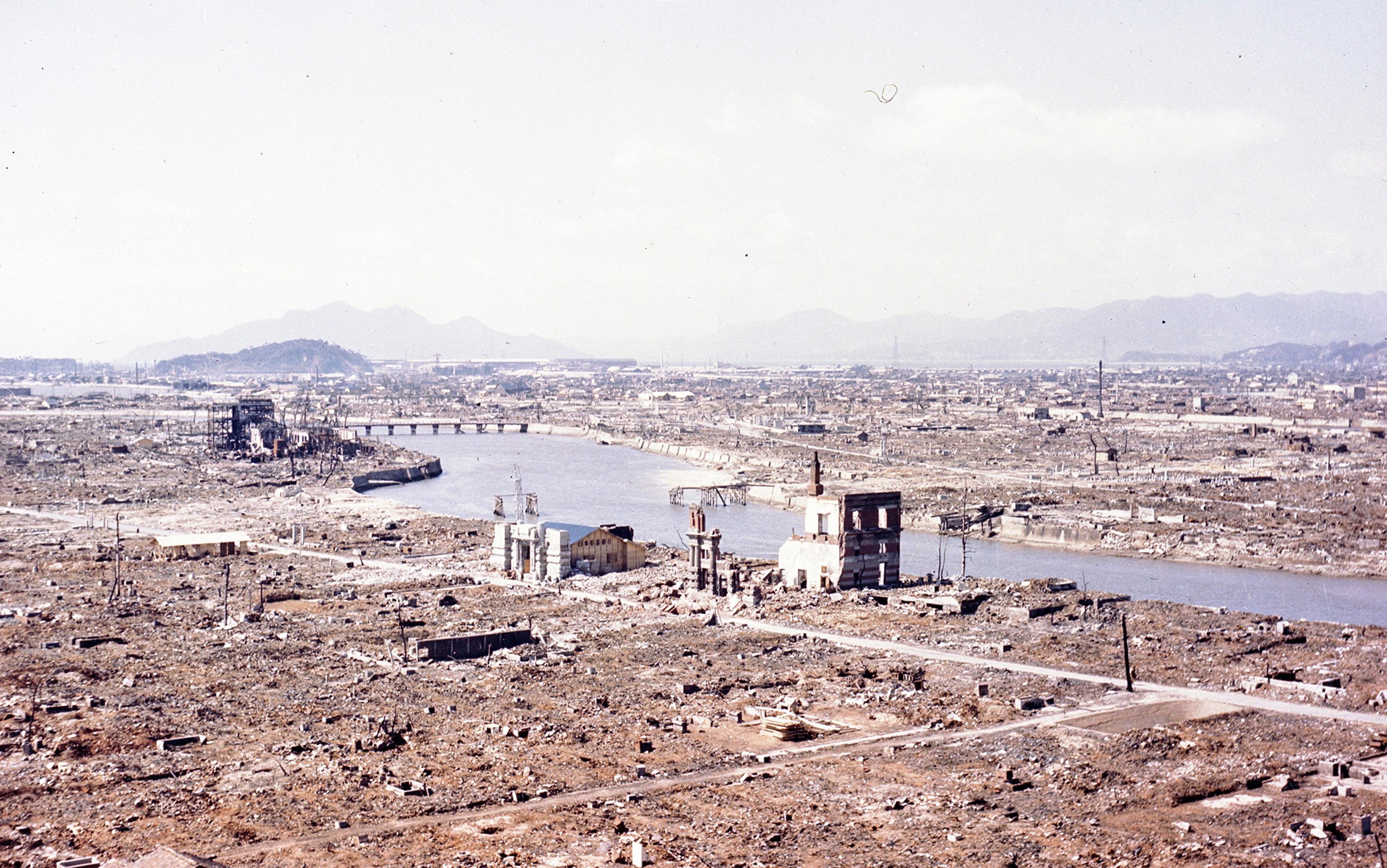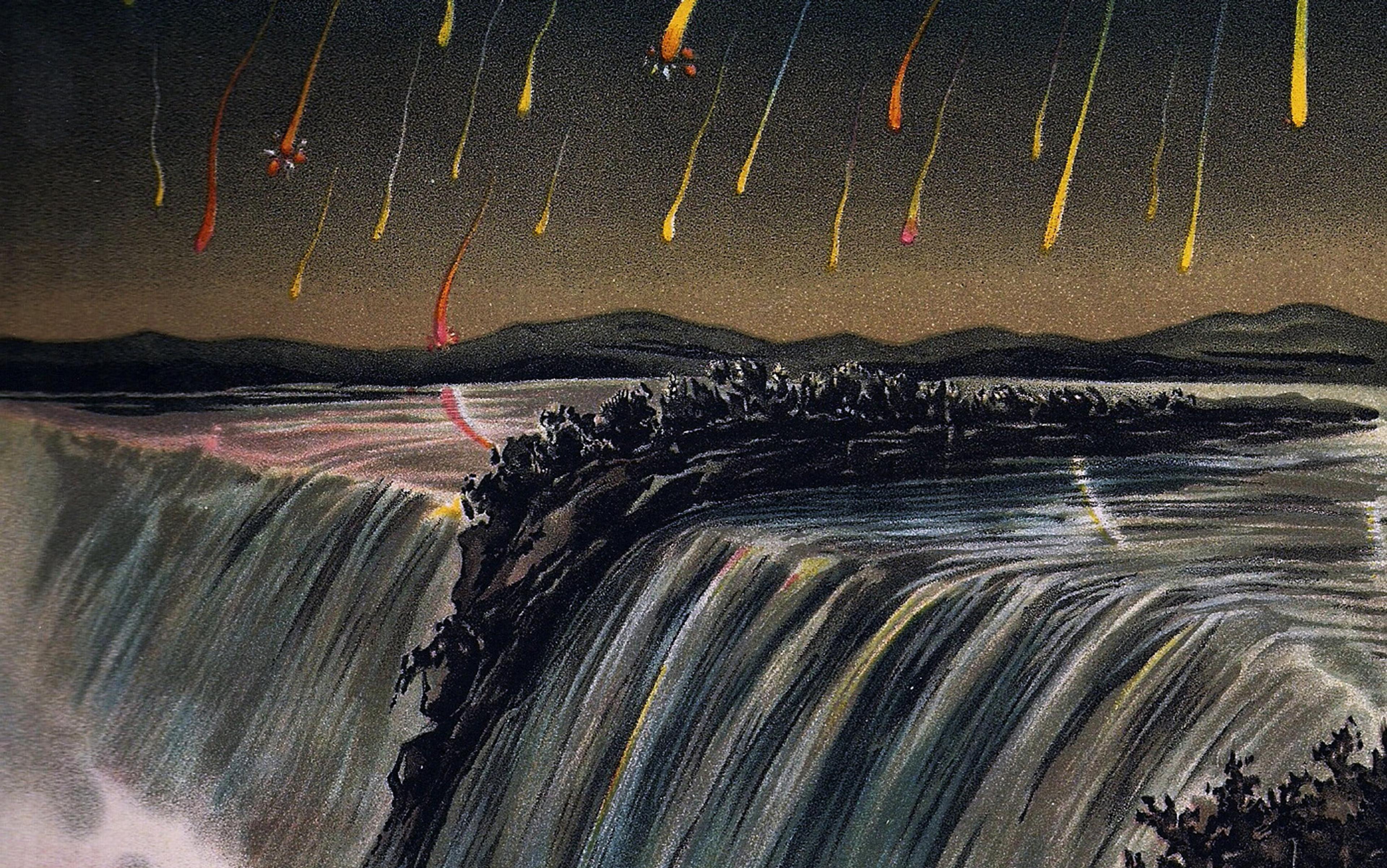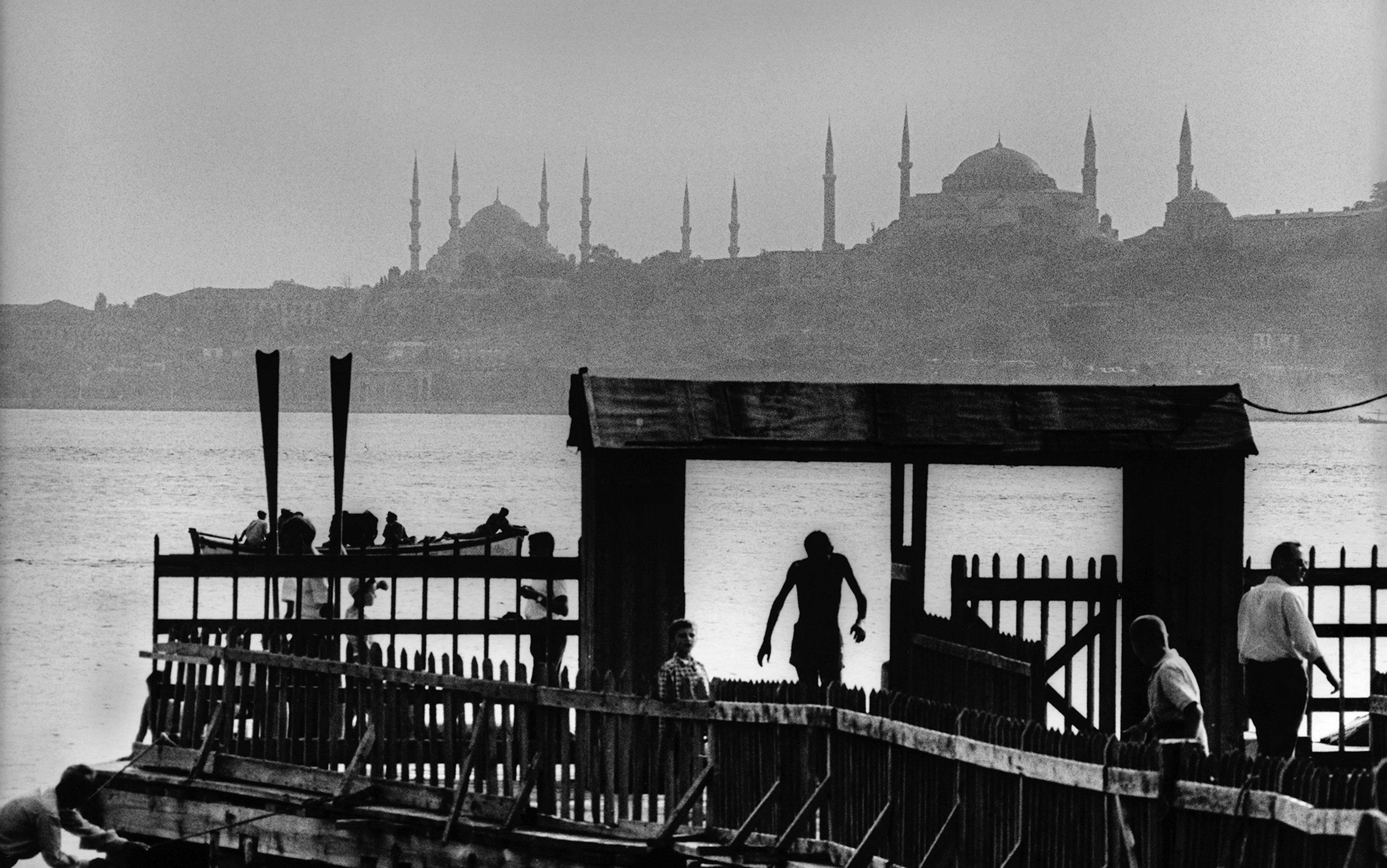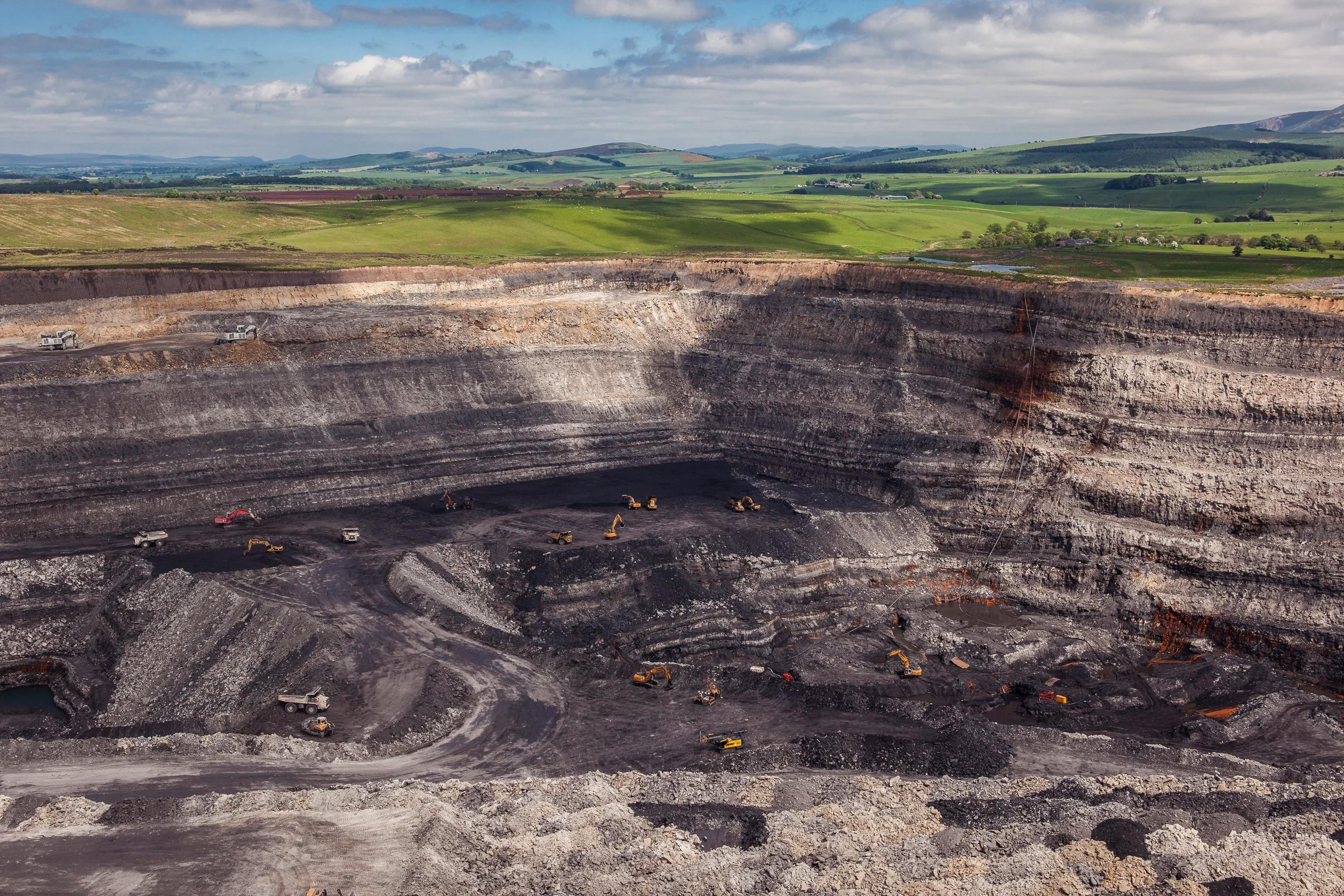On the morning of 16 July 1945, at exactly 05:29:21, an unparalleled bomb was detonated in a United States desert and the world entered the ‘atomic age’. No other period in human history has dawned so explosively or so precisely. No other period has been calculated down to the second. Instead, the dating of cultural periods becomes less and less exact as we move backward through our past toward the fuzzy edges of prehistory, the period in which our species emerged. While the Middle Ages begin sometime around 476 CE, and classical antiquity begins sometime during the 8th century BCE, the prehistoric period emerges over hundreds of thousands of years, possibly 2.5 million years ago.
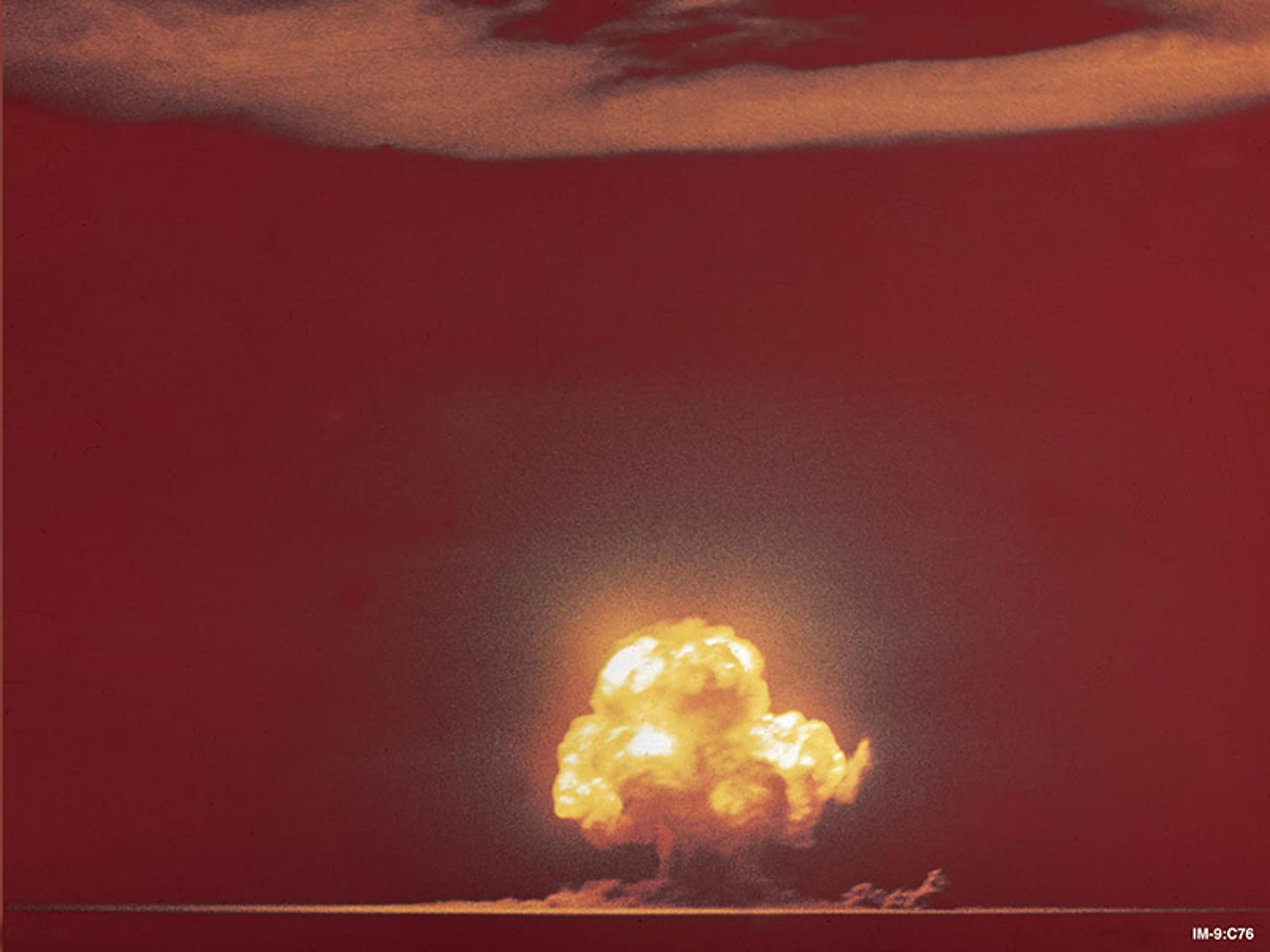
The only extant colour photograph of the first Trinity test, 16 July 1945. The photo was taken by Jack Aeby of the Optics Group. Photo courtesy Los Alamos National Laboratory/Flickr
And while the atomic age starts with a sudden explosion, prehistory begins without a sound. It starts as a mute dawn stretching across geological time, heard only by those excavating landscapes and tombs for traces of our distant hominin ancestors. No two eras from human history began more differently than the atomic age and the prehistoric period. And yet, despite the difference in their temporal constitution and their positions at the extremities of human time – one in the deep past, the other in the 20th century – a reciprocal analogical relationship exists between them. We have learned to imagine one through the other. This analogical relationship has left a lasting mark on the Western historical consciousness, which appears across politics, art and culture, philosophy, and the human and social sciences.
Today, the two ages remain bound together, continuing to illuminate each other’s complexities. And there are indeed complexities, for these two major ‘discoveries’ of modernity remain deeply ambivalent. Both are products of a world becoming more open to human knowledge, unveiled through science and technology, yet the discovery of both periods has also shattered the very premises and operative modes of that knowledge: those who ‘found’ prehistory had to confront a time before (and therefore without) history; and those who learned to split the atom now had to confront possibilities that were difficult to predict or tame. The forms of knowledge that made these discoveries possible, including breakthroughs in quantum physics and anthropology, have not taken us far toward fully understanding these periods. And we do need to understand them, for both prehistory and the atomic age continue to coexist as charged historical figures in the global political imagination, whether through the deep time anxieties surrounding the Anthropocene, or through ongoing fears of nuclear accidents, and nuclear war. As always, to make sense of these concerns in the long term, we must leave the present.
One of the first metaphors that built the imagination of atomic energy was the story of the first mastery of fire, the ancient Greek myth of Prometheus. Through this narrative, the atomic explosion on 16 July 1945, known as the Trinity test, became another ‘great moment in history’. At least, that is how the journalist William L Laurence, one of the few privileged witnesses to the nuclear test, described the explosion in an article for The New York Times in September 1945:
At that great moment in history, ranking with the moment in the long ago when man first put fire to work for him and started on his march to civilization, the vast energy locked within the hearts of the atoms of matter was released for the first time in a burst of flame such as had never before been seen on this planet, illuminating earth and sky for a brief span that seemed eternal with the light of many super-suns.
For Laurence, the detonation marked the apogee of human civilization. But not everyone agreed with this evolutionary vision of history or this framing of the test as an exalted Prometheanism. For some, the new atomic age was far too radical and strange to simply be an extension of our past technological successes. To these observers, it was a rupture with the past. And yet, confronted with the puzzling experiences of the atomic age, they found themselves also seeking metaphors or precedents that could help them assimilate the bewildering changes. Unexpectedly, they too turned toward the ancient human past to understand the world that arrived on 16 July 1945, at 05:29:21. They turned toward an age whose cultural vestiges are striking and enigmatic, a period documented by no written sources and no direct survivors, with a duration whose boundaries are indistinct with natural evolution, fossilisation and geology. In the 20th century, prehistory constituted a symbolic field that never ceased to nourish the anxious thinking of the atomic age.
To Bataille and other intellectuals, Hiroshima became the inverted image of Lascaux
In a lecture delivered on 18 January 1955, the French writer and philosopher Georges Bataille noted the coincidence between the discovery of prehistoric paintings in the Lascaux cave in September 1940, and the ‘atomic experiments’ that took place five years later. To Bataille, the paintings inside Lascaux – depicting fauna living in the area roughly 17,000 years ago, including now-extinct aurochs, deer and other animals – were so astonishingly well preserved, so untouched by the erosion of millennia, that he thought they looked fake. The cave was like a time-capsule, and the time separating the creation and rediscovery of the paintings inside it (by teenagers living near Lascaux) had been so compressed that it was as if prehistorians and moderns were communicating directly.
Through these paintings of animals, ancient humans were able to deliver a message to their modern descendants. For Bataille, the message was clear: the paintings showed the ‘decisive moment’ that the human species emerged from animality, a moment that finds its symmetrical complement and cancellation in Harry Truman’s decision to drop the atomic bomb over Hiroshima on the morning of 6 August 1945. If the sumptuous paintings at Lascaux were expressions of our ancestors ceasing to be mere animals, then the double explosion in Japan had brought the species back toward its animal state as the populations of Hiroshima and Nagasaki were struck by baffling, horrifying bolts of lightning from the sky that eluded their understanding. The extreme violence of the bomb had produced complete unintelligibility, reducing those it struck to death and stupor, and returning human creations and life to dust and stone. Bataille believed that, in the wake of Hiroshima, ‘an avaricious, staggering, interminable revelation began for everyone’; or rather, ‘the opposite of a revelation’. The bomb’s only communication, its only message, was that of annihilation. To Bataille and other intellectuals, Hiroshima became the inverted image of Lascaux.

A temple destroyed by the Nagasaki blast. Photo taken 4 September 1945. Courtesy Wikipedia
This inversion involved more than the relationship between ‘animality’ and ‘humanity’. It also involved a relationship between different ways of using energy and resources. Both the sumptuous frescoes of Lascaux and the atomic bomb involved a gratuitous expenditure, a symbolic surplus. Just as the cave paintings represented a symbolic surplus for our prehistoric ancestors, who chose to use their excess energy to paint images rather than hunt or forage, the bombing of Hiroshima represented a different kind of expenditure. The atomic bomb, though inextricably linked to the capitalist production chain and the generation of gigantic profits (the Manhattan Project cost close to $35 billion in today’s currency), was nonetheless the only collective expenditure of its time that was likely to generate no profit at all.
The bomb defied the profit logic of the 20th-century economics. ‘We, in the middle of the 20th century, are poor,’ Bataille said, ‘we are very poor, we are incapable of undertaking an important job if it has no return. Everything we undertake is submitted to the control of profitability.’ There was, however, one exception: ‘the engineering and materials of destruction, works that today threaten to exterminate the species, and even to end terrestrial life.’ The surplus of the bomb produced the pure and simple eradication of meaning. And the Japanese shock and stupor in Hiroshima and Nagasaki was only a taste of things to come. As the atomic age deepened, the possibility of human extinction grew in parallel with the stockpiling of nuclear weapons. Loud excitement about the future began to turn toward the geological silences of prehistory.
It was not only European philosophers who saw parallels between the atomic and prehistoric ages. Eventually, this analogical relationship was also observed by those responsible for the smooth running of the nuclear chain in the US, and the anti-nuclear intellectuals who analysed the operations of that chain. As the Cold War intensified and nuclear waste proliferated in the late 20th century, the US federal government began to consider analogies between prehistoric monuments and nuclear megastructures. A series of ‘futures panels’ were convened across the country in which experts discussed how to communicate with future societies about the enduring radioactive dangers of the nuclear facilities being built in the 20th century – even if those societies may not share the same languages or cultural references as ours.
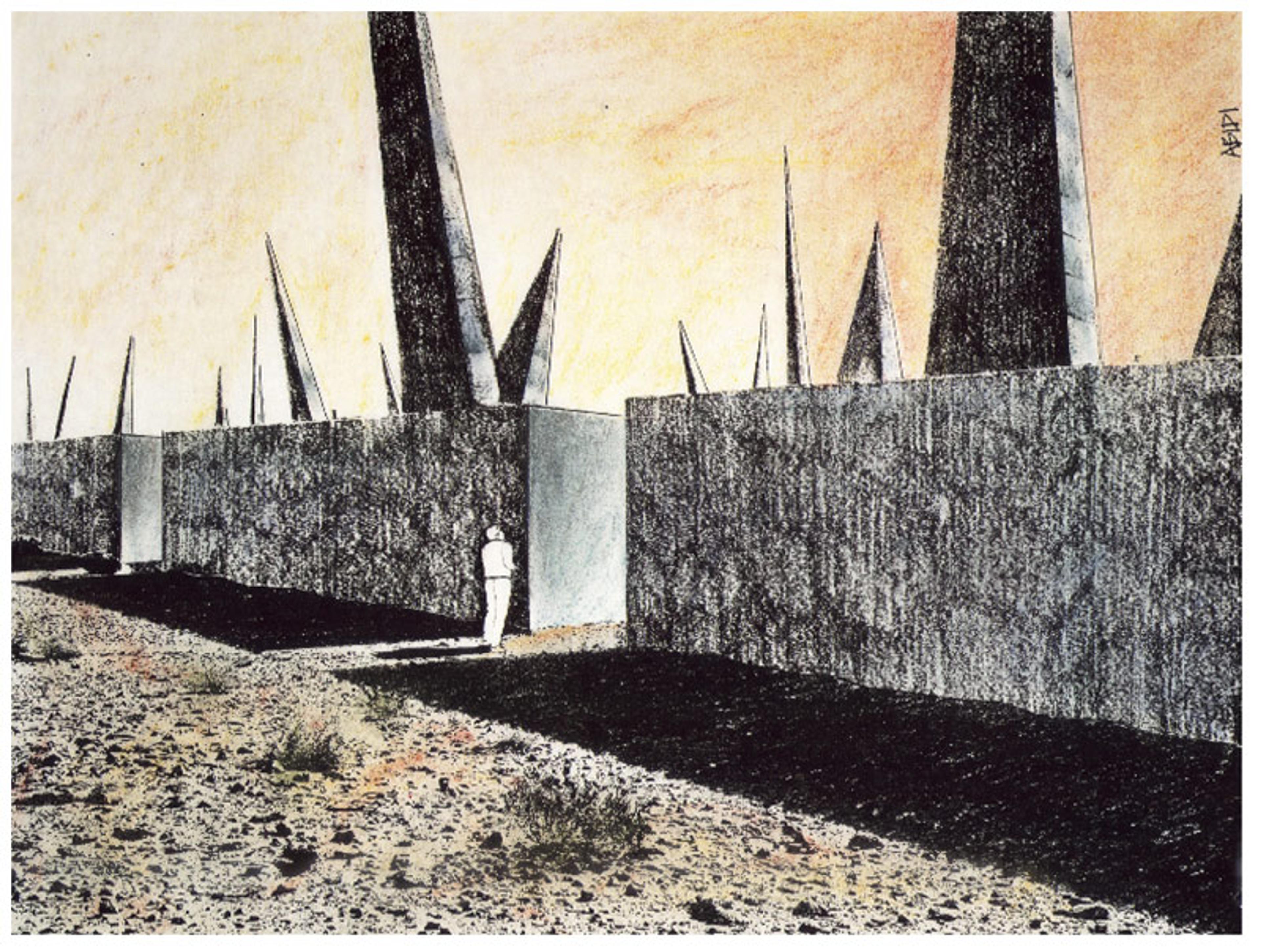
Various proposed designs for the Waste Isolation Pilot Plant. The intention is to deter any human exploration of the site up to 10,000 years from now. Fig 1: ‘Spike Field’. All concepts by Michael Brill, drawings by Safdar Abidi. From the paper ‘Expert Judgment on Markers to Deter Inadvertent Human Intrusion into the Waste Isolation Pilot Plant’ (1993)
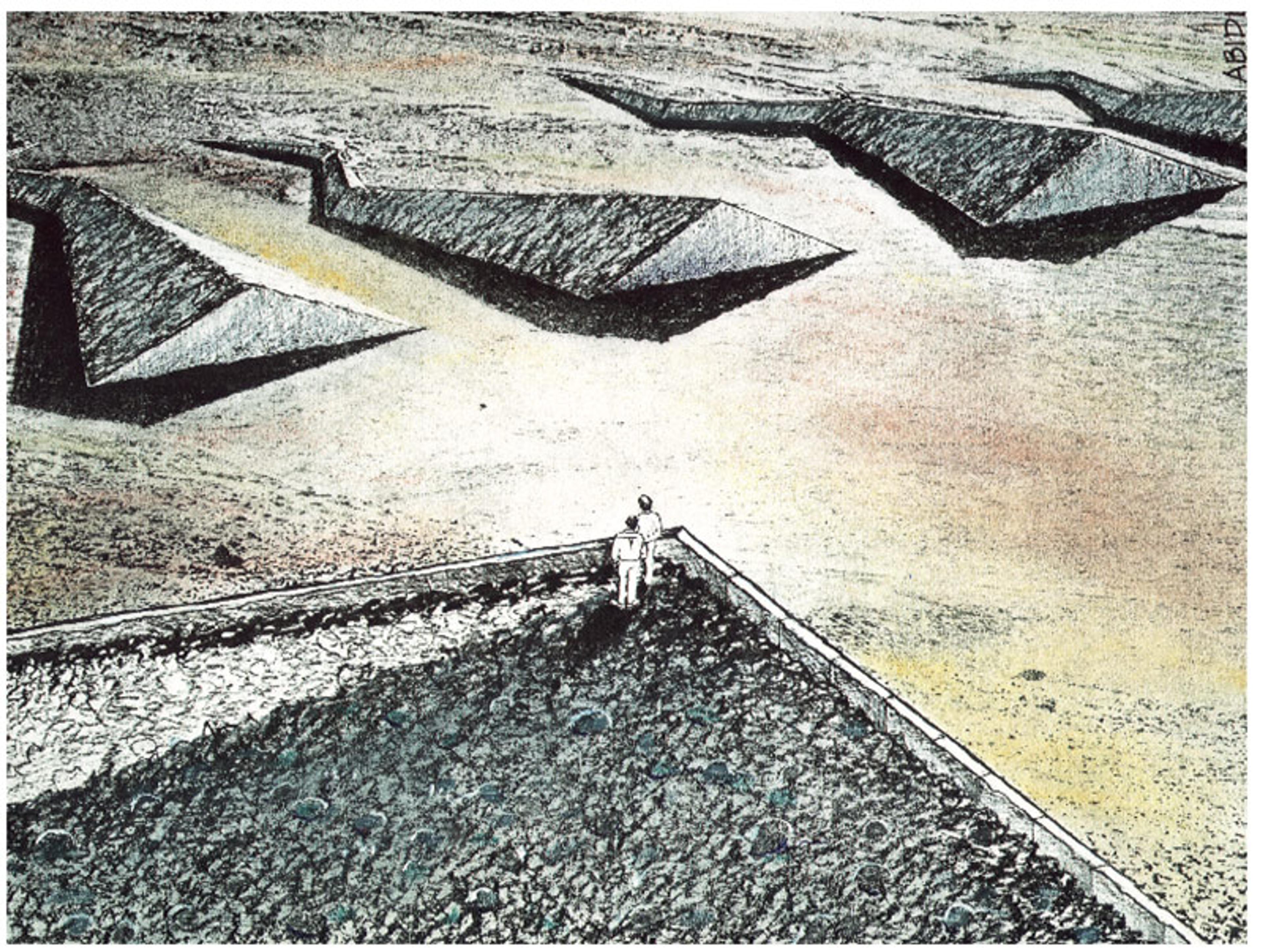
Fig 2: ‘Menacing Earthworks’
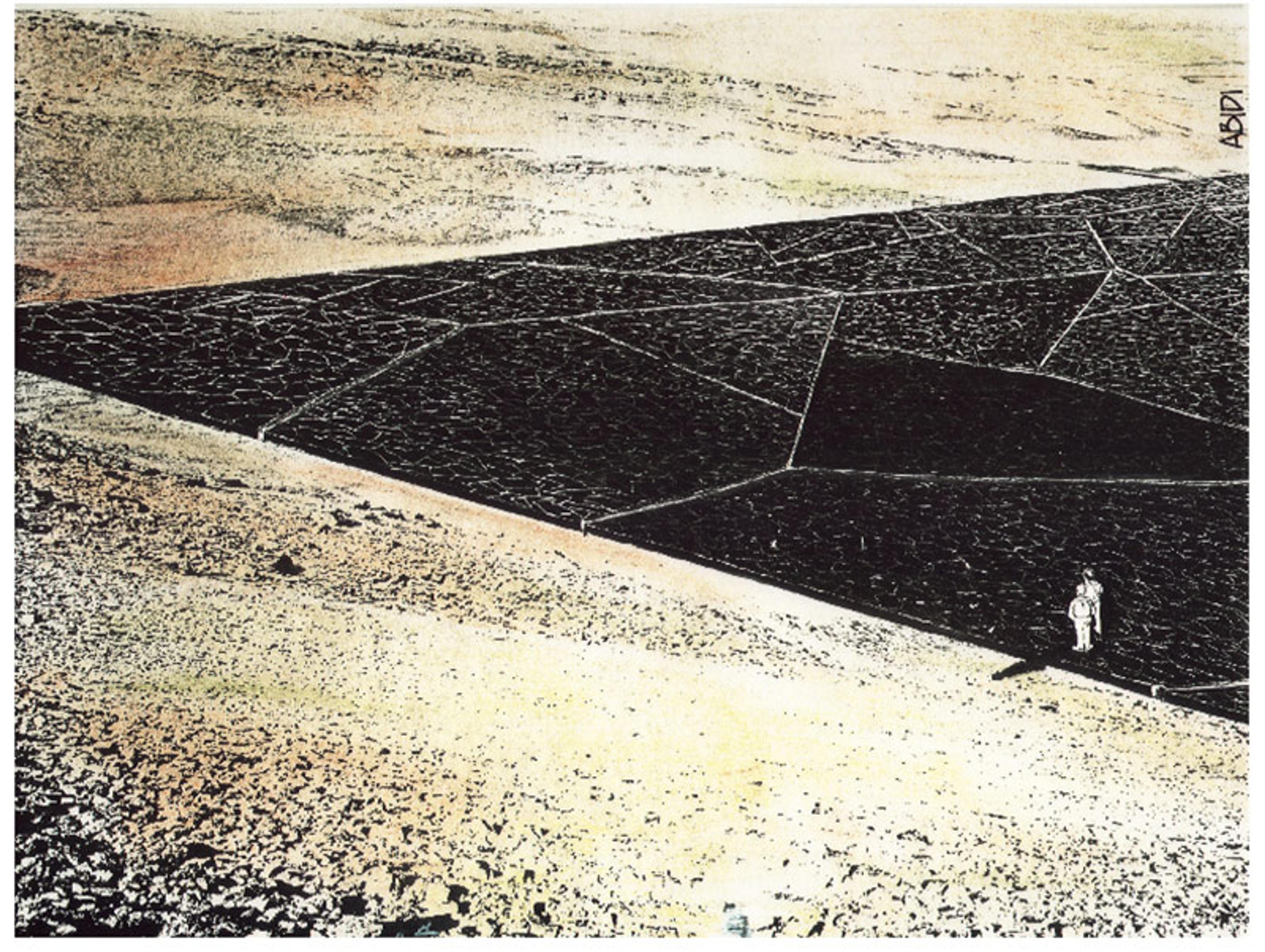
Fig 3: ‘Black Hole’
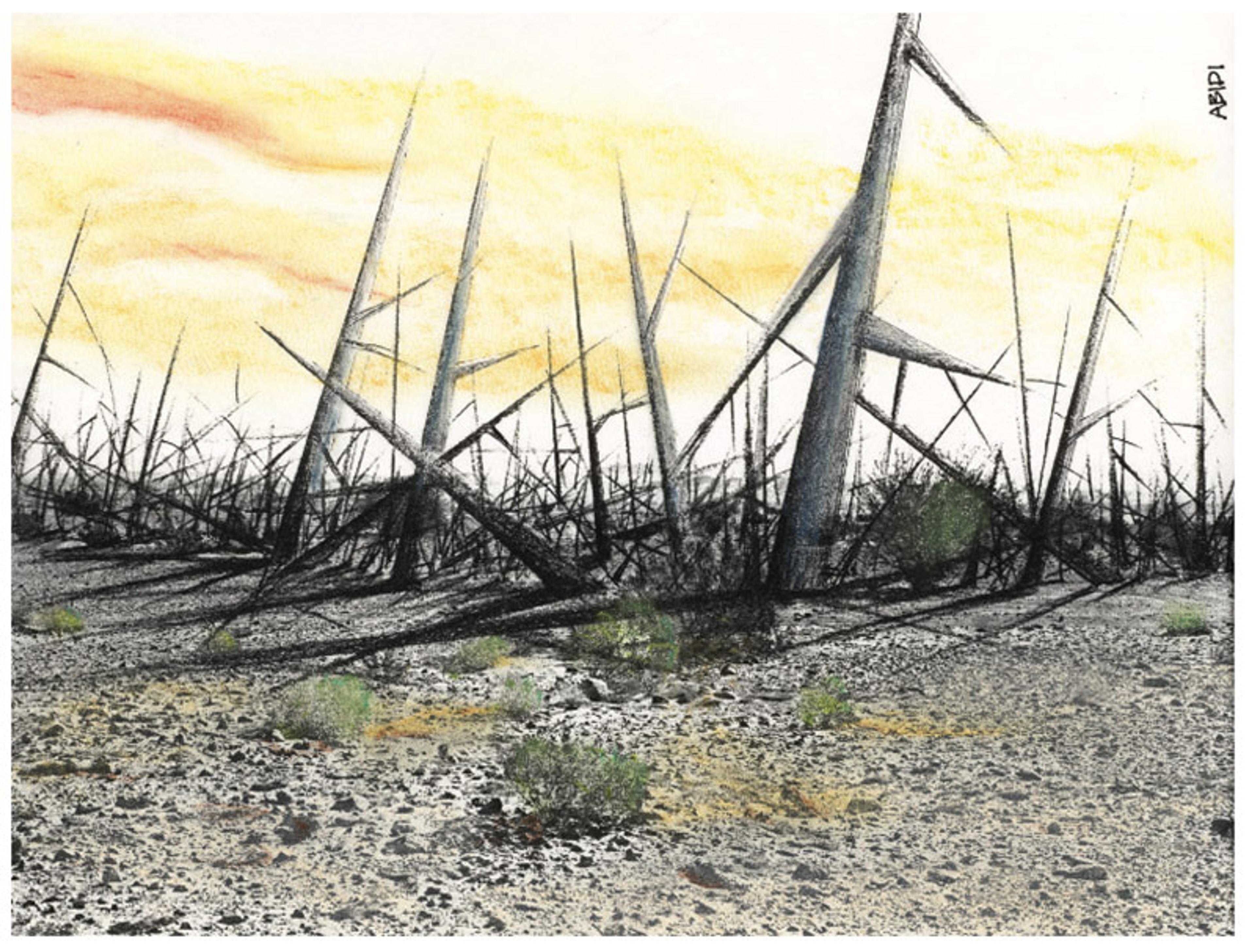
Fig 4: ‘Landscape of Thorns’
The events focused on one specific facility, the Waste Isolation Pilot Plant, which is located underground in New Mexico. The plant was built to store certain forms of dangerous radioactive material, which can remain toxic for thousands of years, perhaps long after our present civilization has ended. And so, a warning system was needed: how could future societies be warned from digging up nuclear waste buried at the facility? The ‘futures panels’ were attended by linguists, geologists, science fiction writers, climatologists, historians, physicists, designers and other specialists who were brought together, one report explained, to ‘develop design characteristics for permanent markers and to judge the efficacy of the markers in deterring inadvertent human intrusion into the Waste Isolation Pilot Plant.’ These markers, attendees were told, would need to be effective for 10,000 years into the future, a timescale that roughly corresponds to the distance that separates us from the Neolithic period.
Did it matter what prehistoric frescoes had meant if they were still communicating messages from the past?
In the same way that prehistoric cave paintings and artefacts communicate messages to us about the past, the goal of the ‘futures panels’ was to communicate with unknown future societies. The problem faced by the experts was how to judge the effectiveness of any messages they proposed. How could anyone be certain a future society would understand them? Paradoxically, the experts turned to the decorated caves and megalithic monuments left behind by prehistoric societies. These monuments showed that, even in the absence of complete and transparent meaning, the enigmatic vestiges of a bygone logic could still transmit strong emotions and rational thought. So, even if the cultural connections between the people building nuclear waste sites and future societies were broken, a message could still be sent. In the final report on the ‘futures panels’, the authors explained the importance of prehistoric sites to their work:
There are particular places (built-forms and natural and made-landscapes) that elicit powerful feelings in almost everybody. These places feel ‘charged’, almost in an electric sense, and the places seem filled with meaning … The places that do carry charge and meaning are sometimes beautiful, but at least as many are ugly, awesome or forbidding. Their importance is in their content (the message), far more than their form, and the success of their forms is in their expressive capacity, not their aesthetics.
These meanings and feelings often come to people in places that are not even of their culture or time. Obvious examples are the way Stonehenge and the painted caves … of Altamira … and Lascaux … evoke profound feelings in modern viewers. This stable and common response to certain places thus seems to transcend particular cultures and particular times … It suggests an origin in something much broader than individual experience and older and deeper than culture, something that is species-wide, part of what it is to be human.
In other words, because all the precise details of prehistoric culture – all the human narratives, myths, rites and functions – had been crushed by the relentless pressure of time, the period presented experts in the 1980s with a language for communicating with the future. Did it matter what prehistoric frescoes or megalithic constructions had meant precisely if they were still effective at communicating messages from the distant past? Was cultural particularity important when prehistory offered a language that was, if not universal, at least universalisable?
It was daring, of course, for the US ‘futures panels’ to equate the eternal harmfulness of nuclear waste with the human need to create collective symbols. It was also daring to equate the physical with the fictional, by linking the bodily impacts of radioactive facilities with the symbolic power of monuments. But in the case of the US federal government, these links were deliberate. Converting the harmful into the sacred, by overlooking the specific contexts of prehistory and the nuclear industry, became the spearhead of political propaganda and state ideology in the atomic age. The physical had to be concealed by the fictional; the monstrous had to be softened through art.
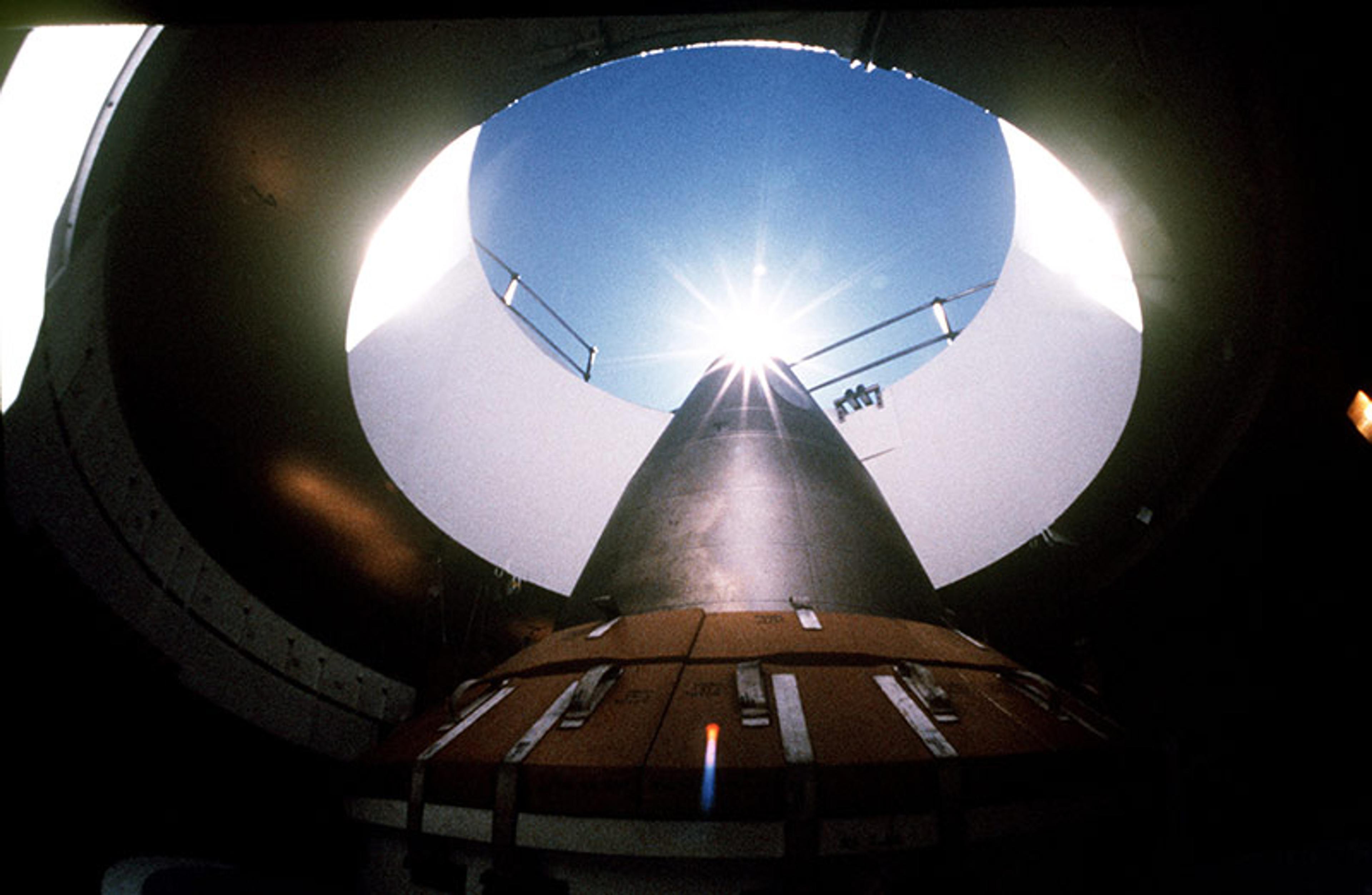
Inside an MX Peacekeeper missile silo, Warren Air Force Base, Wyoming. Photo taken 1987. Courtesy Wikimedia
This mechanism was clearly understood by anti-nuclear activists and the intellectuals that guided such movements, including the British Marxist historian Edward P Thompson. In the 1980s, around the same time that the ‘futures panels’ were being held across the US, Thompson was interrogating NATO’s decision to install intercontinental ballistic missiles in Europe. Like Bataille 30 years earlier, Thompson considered analogies between the symbolic ‘surplus’ of prehistoric art and Cold War civilization. Like the paintings covering the walls of Lascaux, atomic bombs required a gratuitous expenditure. In the 1980s, that expenditure had withdrawn surplus energy, money and other resources from circulation, and redirected them to produce the ultimate Cold War weapon: the MX (‘missile experimental’) missile system, a network of intercontinental ballistic missiles – later named Peacekeepers – armed with thermonuclear warheads and primed to launch from their underground shelters across the US. In his essay ‘Notes on Exterminism, the Last Stage of Civilization’ (1980), Thompson wrote:
It is this surplus which we often take to be indicative of the priorities, the embodied symbols of temporal authority or of spiritual aspiration, which mark the character of a civilization. That surplus, worked up into artefacts, indicates what holds men and women in thrall and what they worship: the great tumuli, the megalithic circles, the temples, the pyramids, the great medieval cathedrals, the giant rockets in their silos, the MX missile system.
All these great constructions through the ages had required the expenditure of labour and immense sacrifice. Like the pyramids or Stonehenge, the giant rockets and MX missiles were not without ‘temporal authority’; they would exercise their power and prestige for a long time to come. And nor were they without ‘spiritual aspiration’; they were no less magical or religious than any constructions of high antiquity. For Thompson, the MX missile system would not only join the ranks of great tumuli or pyramids. It would become the ‘greatest single artefact of any civilization’:
It will be the ultimate serpentine temple of exterminism. The rockets in their shelters, like giant menhirs pointing to the sky, will perform for ‘the free West’ not a military but a spiritual function. They will keep evil spirits at bay, and summon worshippers to the phallic rites of money. Within the aura of those gigantic nuclear circles, the high priests of ideology will perform ritual sacrifices of taxes.
To Thompson, nuclear civilization was deeply irrational. Though the missile silos, weapons, research, waste-storage facilities and other elements of that civilization might be part of an economic system whose main rationality was to make profits, nuclearity had emancipated itself from this logic. It represented the ritualistic destruction of wealth to make weapons of war. In fact, in the atomic age, nuclearity had absorbed the irrationality that once nourished magic and religion during the prehistoric period. And, someday, the reified nuclear ‘surplus’ of the MX missile system would also become ruined, a radioactive temple to be discovered by the archaeologists of the future. But unlike the monuments from prehistory, no meaning would be decipherable in this temple:
Many millennia afterwards, visiting archaeologists from another planet will dig among the still-radioactive embers and debate the function of the great temple. The debate will be in vain. For the temple will be erected to celebrate the ultimate dysfunction of humanity: self-destruct.
In all these examples, the time before history was used to imagine the unimaginable. Sometimes, prehistory’s symbolic remains – tumuli, pyramids, cave paintings – testified to the ways that meaning could be transmitted across expanses of deep time. At other times, these remains were used to envision the ruins of the future and the absolute symbolic indigence promised by nuclear energy in the atomic age. In this way, the prehistoric period became a destination. Through nuclear weapons, the future began to orient toward a mute minerality, a field of extinction stretching across millions of years. This prehistoric future appears to be the most important relationship between the time before history and the atomic age.
We can imagine the time before history and the time after history as two forms, with uncertain beginnings and ends folding back on each other. Their median axis is the brief period of human history, which passes in a flash. This idea was made possible by the invention of deep time in the 18th and 19th centuries, particularly following the publication of Charles Lyell’s Principles of Geology (1830-33), a theme I develop more extensively in my book Transfixed by History (2022). The deep time perspective informed the atomic age, but also the ‘Anthropocene’, which some experts have also dated from the first atomic explosion in 1945. Isotopes from nuclear explosions during the early years of the atomic age can now be identified in geological strata across the world, even in the remotest locations.
After the discovery of deep time, as ancient fossils were historicised and rapidly popularised, humans also began to imagine themselves as potential future fossils. The threat of nuclear war promised by the atomic age made this possibility only more likely. We would be replaced not by other species better adapted to future environments, or by machines, but perhaps by nothing at all. Fears of our demise now shadow the Anthropocene as they did during the atomic age. In deep time, the human species becomes one moment in an endless series of life forms instead of occupying an exceptional place in creation.
Understanding the deep past involved imagining the ruins of humanity
Prehistory opens the door to the possibility of posthistory. In The Medals of Creation (1844), the geologist Gideon A Mantell imagined an indeterminate subject from the future visiting what he called the ‘human epoch’ and studying its sediments:
Their most striking features would be the remains of Man, and the productions of human art – the domes of his temples, the columns of his palaces, the arches of his stupendous bridges of iron and stone, the ruins of his towns and cities, and the durable remains of his earthly tenement imbedded in the rocks and strata – these would be the ‘Medals of Creation’ of the Human Epoch, and transmit to the remotest periods of time, a faithful record of the present condition of the surface of the earth, and of its inhabitants.
In other words, understanding the deep past involved imagining the ruins of humanity and ejecting Homo sapiens from the evolution of life.
These ruins were easy to imagine when Mantell was writing during the mid-19th century, as deep time was being invented and the Industrial Revolution was well underway. At this moment, obsolescence took on new importance. Mechanical automation increasingly reduced human initiative in the production process, threatening to make workers obsolescent, and mechanical products shared with fossils an increased minerality, an impersonal character and a programmed uselessness. What’s more, the economy of progressive acceleration that propelled the Industrial Revolution – capitalism – always held the possibility of regressive acceleration, a movement that threatened to further undermine the status of human exception. The atomic age pushed these possibilities even further. Which technical invention can produce obsolescence more powerfully than nuclearity? Through the annihilation promised by nuclear weapons, obsolescence becomes the horizon of human making and the ultimate endpoint of human culture. To engage that horizon and imagine the posthistoric world, one must take on the role of an expert of the past – a geologist, a palaeontologist, an archaeologist – who will try, in vain, to make sense of the ruins of history.
Was the atomic explosion on the morning of 16 July 1945 a ‘great moment in history, ranking with the moment in the long ago when man first put fire to work’? Today, an evolutionary vision of history, a conquering modernity, no longer enjoys consensus – far from it. Instead, the urgency of history is erupting on all time scales, especially as it becomes clear how human culture is not independent of geology. Rather than a conquering modernity, the spectre of posthistory dominates our imaginations today. In this spectacular and alienating vision, we see the ruins of human society through the eyes of future surveyors, we understand nuclear facilities as monumental temples built to perform sacred rites, we expend a grand surplus in the pursuit of obsolescence. And we stare deeper into the mirror of prehistory.
